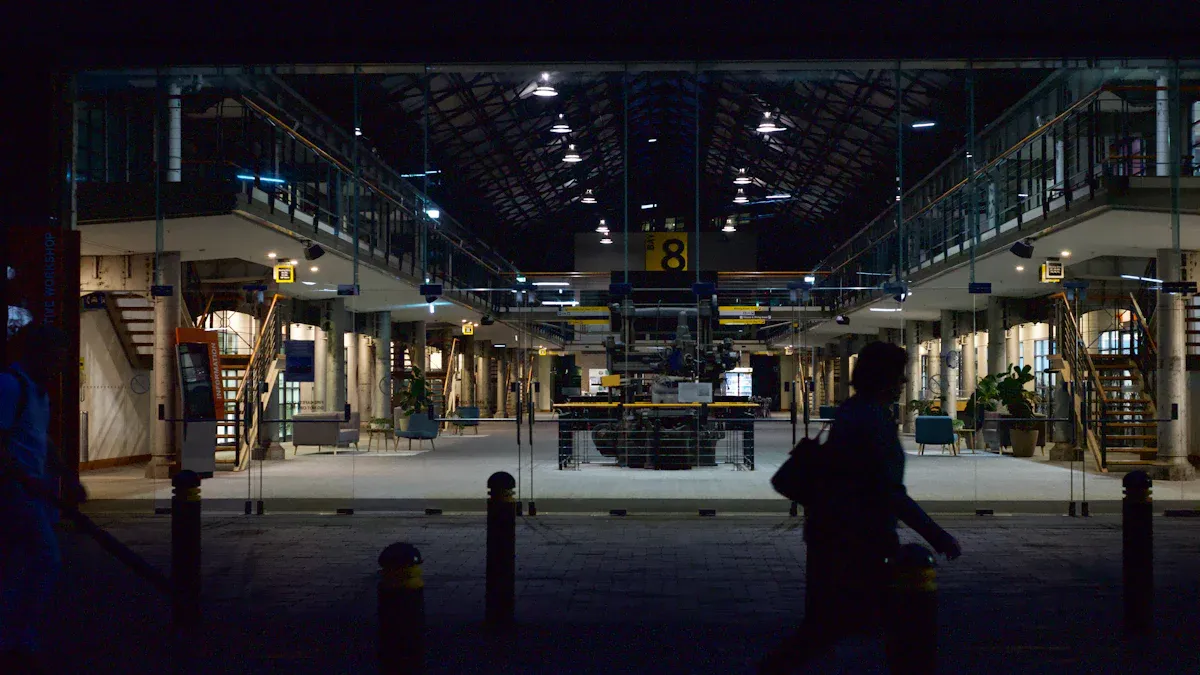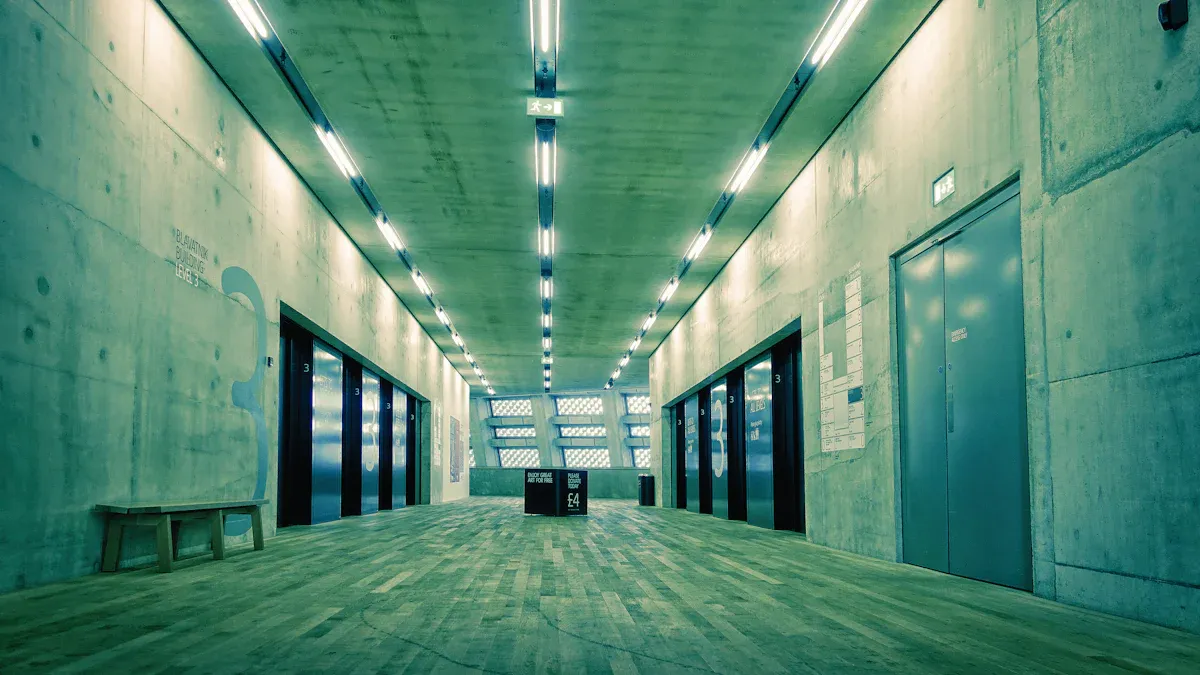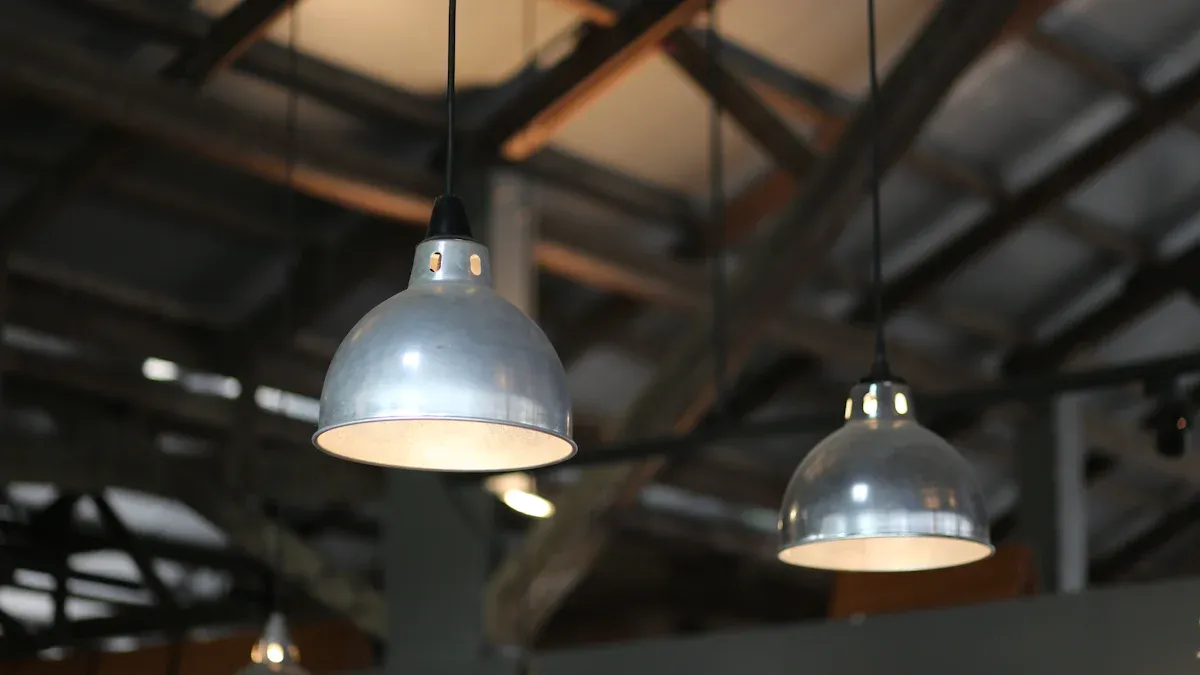High Bay LED Lighting Installation Best Practices for Maximum Performance

You should use best practices with high bay led lighting. This helps you get the best results and stay safe. Good installation gives you even lighting. It also saves energy and money. Your Led Light system will last longer. High bay led lighting makes your workspace safer. You can learn more on our About Us, Home, and Product pages.
Key Takeaways
Measure your space before you plan your lighting. Pick the right fixtures and beam angles. This helps you get even light and save energy.
Stay safe by wearing protective gear. Check the electrical systems first. Use the right mounting hardware for your ceiling type.
Put the lights at the right height and space them out well. This stops shadows and glare. Make sure the wiring is tight to keep things safe and efficient.
Use smart controls like motion sensors and dimmers. These help save energy and make your lights easy to use.
Clean your lights often and check them regularly. This keeps them bright, stops problems, and helps them last longer.
Planning High Bay LED Lighting

Lighting Requirements
First, look at your commercial or industrial space. Measure how big it is and how tall the ceiling is. Check the layout of the area. These things help you know how many high bay led lights you need. The height you hang the lights matters a lot. If your ceiling is 15 to 20 feet high, use a beam angle between 90 and 120 degrees. If your ceiling is higher, use a 60-degree beam angle.
Tip: Putting each fixture in the right spot stops dark spots and shadows. Place high bay led lights about 1.5 to 2 times the mounting height apart. This gives you even lighting. Always think about things like shelves or machines when picking spots for lights.
A good plan makes your space safer and helps people work better. It also saves energy and money by not wasting light or power.
High bay led lighting cuts down on repairs and saves time.
Better lighting makes the workplace safer and helps people do careful work.
Smart controls like occupancy sensors help you use less energy.
Fixture Selection
Picking the right high bay led lights gives you the best results. You should look at some technical details before you choose. Use the table below to compare important things:
Parameter Category | Key Parameters and Ratings |
|---|---|
Initial Performance | Input power (W), Luminous flux (lm), Luminous efficacy (lm/W), Beam angle, CRI, CCT, Height |
Over-time Performance | Lumen maintenance factor (%), Failure rate (%), Control gear reliability |
Standards & Guidelines | Use IEC 62722-2-1 data, Report at actual operating temperature, Full luminaire data |
Always use full luminaire data, not just LED module data. Check how the lights work at the real mounting height and temperature. This helps you get high bay led lights that last a long time and work well.
Code Compliance
You have to follow local rules and standards when you put in high bay led lighting. Following IES guidelines helps you meet safety and brightness rules. Emergency lighting rules are important too. They keep people safe if the power goes out.
Putting emergency fixtures in the right place helps people leave safely. Networked lighting controls can help you follow the rules and save energy. DLC-qualified fixtures might help you get rebates.
Site Preparation
Safety Measures
You must make the work area safe before starting. Always wear gloves, goggles, and a hard hat. Clear the space under where you will work. Put up warning signs or cones to keep others away. Check that ladders and lifts are steady and not broken. Never install high bay LED lighting by yourself. Having someone with you keeps you safer and helps you work faster.
Tip: Check your tools and equipment before you start. Using safe tools stops accidents and saves time.
Electrical Checks
Look at the electrical system before putting in fixtures. Turn off the power at the breaker box first. Use a voltage tester to make sure wires are not live. Look at all wires for damage or wear. If you find problems, call a licensed electrician for help. You also need to check if your circuits can handle the load. High bay LED lights need the right voltage and amperage to work. If you put mounting hardware near wires, stay far enough away to be safe.
Mounting Surface Prep
Get the mounting surfaces ready for your new lights. Clean where you will put each fixture. Remove dust, grease, or old hardware from the area. Strong and clean spots help your lights stay in place. Use the right anchors and brackets for your ceiling type. Concrete, metal, and wood ceilings need different fasteners. You can add reflectors or diffusers to spread light better and cut down glare. These extras make your lights look good and work better.
Note: Putting in mounting hardware the right way keeps fixtures tight. Always follow the manufacturer's instructions for the best results.
Installation Best Practices

Optimal Mounting Height
You must set the best mounting height for your high bay led lights. The height changes how much space each fixture lights up. It also changes how bright the room feels. For ceilings between 15 and 20 feet, hang the fixtures at 12 to 18 feet. This gives strong light but does not cause glare. If your ceiling is taller, you should hang the lights higher. Always look at the manufacturer’s advice for each fixture.
Tip: Change the mounting height to stop shadows and dark spots. The right height gives even light and helps you save energy.
Think about what people do in the area when you pick the height. Warehouses with tall racks may need lights hung higher. Open places like gyms often use lower heights for even light. Hanging the fixtures at the right height saves energy and makes the system work better.
Fixture Spacing
Good fixture spacing works with mounting height to give even light. Put high bay led lights 10 to 12 feet apart for ceilings between 15 and 19 feet. This stops dark spots and keeps the light level steady. If you hang the lights higher, put them farther apart. Always measure the room and mark where each fixture will go before you start.
Use a layout grid to plan where to put fixtures.
Do not put fixtures too close to walls or big machines.
Change the spacing if you see shadows or uneven light during testing.
The right spacing and mounting height together give balanced light. You get the most from your high bay led lighting and save energy.
Secure Wiring
Safe wiring is very important for every installation. You keep people and equipment safe by following these steps:
Use a power source that matches your high bay led lights.
Follow the manufacturer’s wiring steps for each fixture.
Use the right wire colors: black for hot, white for neutral, green or bare for ground.
Make all wire connections tight with wire nuts and tape.
Note: Tight wiring connections stop electrical problems and keep your lights working well. Always check your work before turning the power back on.
When you hang the fixtures, make sure the wires do not pull or hang down. Use cable clips or conduit to keep wires neat and safe. Good wiring helps your high bay led lights last longer and saves energy.
Controls Integration
Smart controls help your high bay led lighting use less energy. You can add motion sensors, dimmers, and daylight sensors to your system. These controls help you save energy and lower your bills.
Motion sensors turn lights on when someone comes in and off when they leave.
Dimmers let you change how bright the lights are, which saves power and helps bulbs last longer.
Daylight sensors change the light level when there is more sunlight.
Smart controls make lighting automatic, so you only use what you need.
TRUEiSENSE smart high bay led lights can save up to 70% on energy by using motion and daylight sensors. These features help you meet green goals and lower your carbon footprint. You also get remote access and easy control, so your lighting system is simple to use.
Tip: Add controls during installation to get the most from your energy efficient lighting. Smart controls work best when you set the right height and spacing.
When you use the right mounting height, good spacing, safe wiring, and smart controls, your high bay led lighting system will be efficient, safe, and give even light.
Post-Installation Checks
Light Testing
After you finish the installation, you need to check the lights. Walk through the area and look at every fixture. Turn on all the high bay LED lights. Make sure you see uniform illumination across the space. If you notice shadows or dark spots, adjust the fixtures or their angles. Use a light meter if you have one. This tool helps you measure the brightness in different spots. You want every area to have the same level of illumination. Good light testing helps you reach optimal lighting performance and keeps your workspace safe.
Tip: Test the lights at different times of day. Sunlight can change how your space looks. Make sure your lighting works well in all conditions.
Safety Verification
You must check the electrical safety after installing new lights. Electrical safety audits show that you should always inspect the system right after installation. These audits help you find new hazards, such as overloaded circuits or loose connections. You should:
Review all installation documents and wiring diagrams.
Inspect each fixture for proper mounting and secure wiring.
Look for signs of overheating or damaged parts.
Check that all circuits follow safety standards like NFPA 70E and OSHA.
Create a plan to fix any problems you find and review your work later.
This process keeps your lighting system safe and reliable. You protect your team and your equipment by following these steps.
Control Adjustment
Smart controls help you save energy and improve lighting quality. After you finish the installation, test all motion sensors, dimmers, and daylight sensors. Walk through the area and see if the lights respond as they should. Adjust the settings so the lights turn on and off at the right times. Make sure the controls help you keep uniform illumination without wasting energy. If you use remote controls, check that you can manage the system from your device.
Note: Adjusting controls after installation helps you get the best results from your high bay LED lighting system.
Maintenance Tips
Cleaning
You should keep your high bay LED lights clean to get the best performance. Dust and debris can build up on the fixtures. This buildup blocks light and lowers brightness. Use a soft cloth or a gentle brush to wipe the surfaces. Avoid using harsh chemicals that can damage the lens or housing. Clean the lights at least once every few months. If your space is dusty, you may need to clean them more often. Good cleaning habits help your lights shine brighter and last longer.
Tip: Turn off the power before cleaning any fixture. This keeps you safe and protects the equipment.
Inspections
You need to inspect your lighting system on a regular schedule. Look for signs of wear, loose wires, or damaged parts. Check for flickering or dimming, which can signal a problem. Review key performance metrics like lumen output, color temperature, and energy efficiency. Use a checklist to make sure you do not miss anything. Keep records of all maintenance activities. These records help you track fixture reliability and plan for replacements. Regular inspections support the longevity of your lighting system.
Check for dust or debris on fixtures.
Look for cracks or discoloration.
Test all controls and sensors.
Make sure all fixtures meet local electrical codes.
Troubleshooting
Sometimes, problems can happen even with good maintenance. If a light flickers or does not turn on, check the wiring first. Make sure all connections are tight. Replace any damaged parts right away. If you see dimming, test the power supply and look for signs of overheating. For smart controls, reset the system if sensors do not respond. Always follow the manufacturer's instructions for repairs. If you cannot fix the issue, call a qualified electrician.
Maintenance tips like these help you avoid bigger problems and keep your lighting system working well. Regular maintenance ensures safety, saves money, and extends the life of your high bay LED lights.
You get the best results from high bay LED lighting by following every step.
Make a plan for where to put your lights and pick the right fixtures.
Get your work area ready and look at all the electrical parts.
Put the lights up at the right height and space them out evenly.
Check your system often and take care of it to keep it working well.
Keep up with new lighting rules and keep learning more. Doing these steps all the time helps you make your lighting safe, efficient, and dependable.
FAQ
How often should you clean high bay LED lights?
You should clean your high bay LED lights every three to six months. Dust and dirt can block light and lower brightness. In dusty areas, clean more often to keep your lighting system working well.
Can you install high bay LED lights yourself?
You can install high bay LED lights if you have electrical experience. Always follow safety rules and turn off the power. If you feel unsure, hire a licensed electrician to avoid risks.
What is the best way to avoid glare from high bay LED fixtures?
You can avoid glare by using diffusers or reflectors. Set the correct mounting height and angle for each fixture. This setup helps spread light evenly and keeps your workspace comfortable.
Do high bay LED lights work with smart controls?
Yes, most high bay LED lights support smart controls like motion sensors and dimmers. You can add these features during installation to save energy and improve lighting performance.

